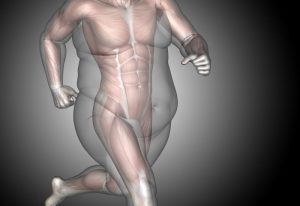A new study conducted by an international team of researchers demonstrated that the circadian rhythm impacts healthy fat tissue function. The study, recently published in Nature, showed that circadian rhythm disruption, especially when paired with a high fat diet, can have long-term effects on fat tissue and where fat is stored in the body.
Fat cells operate according to a 24-hour cycle; when that rhythm is disrupted and fat tissue is further stressed by a high fat diet, the results can be long-lasting and difficult to reverse.
Healthy Fat Tissue Performs Vital Functions
 With so much focus on the health problems associated with excess fat and obesity, it can be easy to forget that healthy fat tissue does, in fact, perform vital functions within the body. Healthy fat tissue provides the body with energy, helps to protect the organs, has a role in cell growth and helps to maintain correct body temperature.
With so much focus on the health problems associated with excess fat and obesity, it can be easy to forget that healthy fat tissue does, in fact, perform vital functions within the body. Healthy fat tissue provides the body with energy, helps to protect the organs, has a role in cell growth and helps to maintain correct body temperature.
Maintaining the health and function of fat tissue is essential to good health. Interestingly, a healthy circadian rhythm is an important part of that.
Circadian Rhythm Impacts Healthy Fat Tissue
As explained by the researchers that conducted this recent study, timing and rhythm are essential elements in the correct functioning of fat tissue. Throughout the body, there are body clocks that regulate cellar activities. The circadian rhythm, an approximately 24-hour cycle, is an essential part of the synchronizing of those clocks.
Like all life on Earth, we humans have evolved to that 24-hour rhythm of light and dark, day and night. For most of our existence as a species, we’ve been active in the daylight hours and have slept during the dark hours of night.
Healthy fat tissue also operates on a roughly 24-hour cycle. During that period of time, adipocyte progenitor cells develop into adipocytes, the specialized cells that form adipose tissue, or healthy fat tissue. This is the tissue that stores energy. The circadian rhythm is connected to this process via its role in regulating body clocks throughout the body. The timing of cellular operations is thus influenced by the long established rhythms of human life; the regular rhythms of waking, eating, being active and sleeping.
Light and meal timing are two of the major cues for the circadian rhythm and both are seriously impacted by modern living. Bright lights at the flip of a switch make it easy to extend the day far into the night. Food abundance and the ready availability of convenience foods, often high fat and sugar, has changed the way we eat and also when we eat. These disruptions to the circadian rhythm and diet can cause real damage to the way the human body processes, utilizes and stores fat; damage that can be difficult to undo, even by improving diet.
According to the study, a lifestyle that routinely combines circadian rhythm disruption and a high fat diet can actually disrupt the cellular processes involved in transforming adipocyte progenitor cells into healthy fat tissue, leading to a depletion of healthy fat cells. That, in turn, causes problems with the storage of fat, allowing lipids, or fat, to spill over into other areas, creating an excess of fat around organs and muscles. When that happens, the risk of insulin resistance and type two diabetes increases significantly. According to the study, this type of fat system disruption could be difficult to reverse.
Maintaining Circadian Rhythm Health
A healthy circadian rhythm is a key element of overall health and well-being. There are a number of factors involved in maintaining circadian rhythm health. These include the timing of light exposure, meal timing, diet, physical activity and sleep quality.
Get morning sunshine exposure daily and avoid bright artificial lights, including light from screens and devices, in the evening, particularly during the two hours before bedtime. Have a regular schedule for sleeping and waking. Keep it the same every day, both on weekdays and weekends.

Eating during the active part of the day is better for your health in general. Avoid high fat, sodium and sugar convenience foods and stay away from empty calories. Instead, choose whole foods, complex carbohydrates, lean proteins and healthy fats. Make sure that the active part of your day includes enough physical activity. That will promote better sleep and a healthier circadian rhythm.
Live Rhythmically, Reduce Disruption
While life does serve up its challenges and disruptions, there is a lot you can do to live yours in a more rhythmic fashion, reducing circadian rhythm disruption. It may seem challenging at first to get the different elements of your life into a manageable rhythm, but you’ll feel better and be healthier as things fall into place, choice by choice and day by day.







